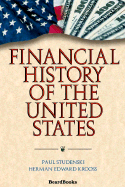|
|
|
|
||||||

|
Financial History of the United States This well documented book will appeal to economists, historians, political scientists, and anyone eager to understand the intertwining of the political and economic actions in our society. Publisher Comments
This work analyzes how political issues influence public finance, particularly governmental monetary, credit, and foreign trade controls. It aims to promote a better understanding of the genesis, interrelationships, and effects of governmental fiscal, monetary, banking, and tariff policies and institutional arrangements. The authors trace the theories that underlie financial practice, believing that the advances and mistakes made by each generation can be found in the forces that shaped events. From Book News, Inc.: Looking at both public finance and developments in tariffs and banking regulation, the authors (both economics professors at New York U. at the time of writing this book) trace the development of U.S. financial policies at the local, state, and federal levels. The narrative runs from colonial days to just after World War II. The authors explore the rationales given for implementing policy and explore the impact of non-financial political events on the formation of policy. This is a paperbound reprint of a work first published in 1952. Annotation ©2003 Paul Studenski, 1887-1961, was born and raised in Russia. He studied law in Russia and then medicine at the Sorbonne in Paris. He entered a brief but accomplished career in aviation and his feats in this regard can be found in a collection at the National Air and Space Museum. He then returned to academe, and received a doctorate from Columbia University in 1921. This was followed by a distinguished career in teaching and government service. He was a Professor of Economics at New York University from 1927 to 1955, and followed this for two years as Director of the Albany Graduate Program in Public Administration. He was a highly regarded consultant and adviser, and authored many books. Herman Edward Krooss, 1912-1975, was an educator and author. He received a Ph.B. from Muhlenberg College in 1934, an M.A. from the University of Pennsylvania in 1935, and a Ph.D. from New York University in 1947. He was on the faculty at New York University from 1947 to 1975, which included being a Professor of Economics from 1953 to 1975 and Department Chairman from 1959 to 1965. He was the author or editor of numerous books.
|
|||||||||||||||||||||||||||||||||||||||||||||||||||||||||||||||||||||||||||||||||||||||||||||||||||||||||||||||||||||||||||
|
|
|
home
| about
us | contact
us | related
sites |